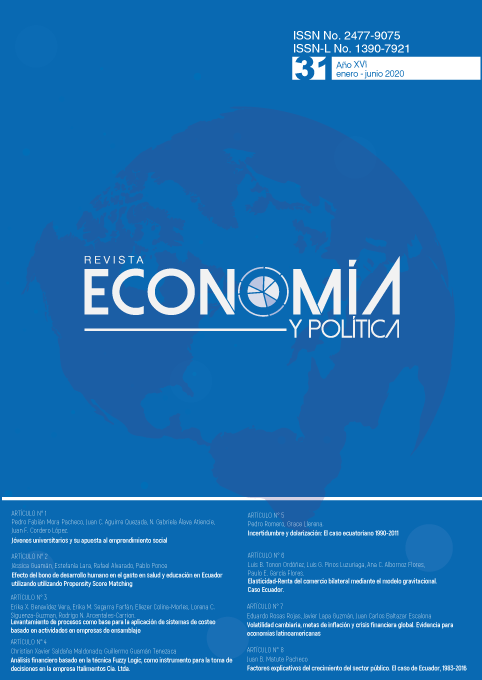Relación entre la competitividad y el desarrollo regional en Ecuador: una aplicación de modelos espaciales
DOI:
https://doi.org/10.25097/rep.n31.2020.06Keywords:
Competitividad regional, desarrollo regional, EcuadorAbstract
Competitiveness plays a relevant role in understanding the development processes of countries, regions, cities or companies. The evidence shows that isolated investments do not necessarily lead to development, without requiring a set of natural or acquired endowments to enhance internal strengths. This research has two objectives. First, build a competitiveness index for the cantons of Ecuador. Second, examine the relationship between the competitiveness index and cantonal development. In order to meet the objectives, the methodology proposed by the World Economic Forum and spatial econometric models are used, respectively. The results show significant differences in the levels of cantonal competitiveness caused by differences in access to health, education, technology and institutional factors. In addition, we find that higher competitive rates positively influence local and territorial development. Our results offer new evidence on the importance of regional competitiveness for the design of public policies that promote the development of peripheral cantons.
Downloads
References
Amate, I., & Guarnido, A. (2011). Factores determinantes del desarrollo económico y social. Unicaja Fundación,
Annoni, P., & Kozovska, K. (2010). EU Regional Competitiveness Index 2010. Luxembourg, European,
Anselin, L. (1988). Spatial Econometrics: Methods and Models. Dordrecht: Kluwer Academic Publishers.
Anselin, L., & Bera, A. (1998). Spatial dependence in linear regression models with an introduction to spatial econometrics. In A. Ullah & D. Giles (Eds.), Handbook of Applied Economic Statistics. New York: Marcel Dekker.
Asheim, B. T. (1996). Industrial districts as "learning regions": a condition for prosperity. European Planning Studies, (4), 379–400.
AVSI. (2008). Capital Humano, recurso para el desarrollo
Bronisz, U., Heijman, W., & Miszczuk, A. (2008). Regional Competitiveness in Poland: Creating an Index. Open Access, (28), 133–143.
Cooke, P. (2001). Regional innovation systems, clusters, and the knowledge economy. Industrial and Corporate Change, (10), 945–974.
Cooke, P., Uranga, M., & Extebarria, G. (1998). Regional innovation systems: an evolutionary perspective. Environment and Planning A, (30), 1563–1584.
CPC& CEPEC. (2013). Índice Departamental de Competitividad 2013.
Días, D., & Fernández, M. (s.f.). Desarrollo Económico: Mediciones de Crecimiento y Desarrollo: Indicadores y Enfoques. Universidad de Cantabria,
Du, Q., Wang, Y., Ren, F., Zhao, Z., Liu, H., Wu, C., Shen, Y. (2014). Measuring and Analysis of Urban Competitiveness of Chinese Provincial Capitals in 2010 under the Constraints of Major Function-Oriented Zoning Utilizing Spatial Analysis. Sustainability, (6), 3374–3399. Retrieved from www.mdpi.com/journal/sustainability
Helmsing, A. H. J. (2001). Partnerships, meso-institutions and learning: new local and regional economic development initiatives in Latin America. Institute of Social Studies, The Hague, The Netherlands.
Huggins, R., & Davies, W. (2006). European Competitiveness Index 2006-07. University of Wales Institute. Cardiff-UWIC: Robert Huggins Associate Ltd. Retrieved from http://www.cforic.org/downloads.php
Huovari, J., Kangasharju, A., & Alanen, A. (2001). Constructing an index for regional competitiveness. Helsinki: Peelervo Economic Research Institute - Working paper No 44.
IMCO. (2012). Índice de Competitividad Urbana 2012: El municipio: una institución diseñada para el fracaso. Instituto Mexicano para la Competitividad A.C.
IMD. (2008). World Competitiveness Yearbook 2008. Institute for Management Development. Lausanne, Switzerland
INEC. (2010). Censo de Población y Vivienda 2010. Base de Datos.
INEC. (2010). Censo Nacional Económico 2010. Base de Datos.
INEC. (2013). Encuesta Nacional de Actividades de Ciencia y Tecnología 2013. Base de Datos.
Jimenez, J., & Alvarado, R. (2018). Effect of labor productivity and human capital on regional poverty in Ecuador. Journal of Regional Research, (40), 141-165.
Kosacoff, B. (2005). El papel de la empresa en el desarrollo económico. CEPAL.
LeSage, J., & Pace, R. (2009). Introduction to Spatial Econometrics. London: CRC Press.
Martin, R., Kitson, M., & Tyler, P. (Eds.). (2006). Regional Competitiveness. London & New York: Routledge.
MENDIETA MUÑOZ, R., RĂILEANU-SZELES, M., BELTRÁN ROMERO, P., & PIEDRA PEÑA, J. A. (2015). Explaining the regional economic heterogeneity in Ecuador. Bulletin of the Transilvania University of Brasov. Series V: Economic Sciences, 8(2).
Mortimore, M., & Peres, W. (2001). La competitividad empresarial en América Latina y el Caribe. CEPAL, (74), 37–59.
Ochoa, S., & Celi, A. (2012). Factores de Competitividad Regional en Ecuador 2010 (Informe de Coyuntura Económica No. 10). Universidad Técnica Particular de Loja, Loja, Ecuador.
Olivares, F. (2012). Índice de Competitividad Regional 2011. Centro de Estudios en Economía y Negocios - Universidad del Desarrollo,
Ord, J. (1975). Estimation Methods for Models of Spatial Interaction. Journal of the American Statistical Association, (70), 120–126.
Pastor, C. (2014). Índice de Competitividad Regional 2014. Instituto Peruano de Economía.
Porter, M. E. (1981). The contributions of industrial organization to strategic management: a promise beginning to be realized. Academy of Management Review, (6), 609–620.
Schumpeter, J. A. (1950). Capitalism, Socialism, and Democracy (3rd). New York: Harper & Row.
Schwab, K. (2014). The Global Competitiveness Report 2014-2015. World Economic Forum. Geneva, Switzerland.
Silva Lira, I. (2005). Desarrollo económico local y competitividad territorial en América Latina. Revista de la CEPAL.
So, M., & Shen, J. (2004). Measuring Urban Competitiveness in China. Asian Geographer, 23(1-2), 71–91.
Storper, M. (1997). The Regional World: Territorial Development in a Global Economy. New York: Guilford.
UNDP. (2008). Regional Competitiveness Index Croatia 2007. Zagreb: United Nations Development Programme.
Whittle, P. (1954). On stationary processes in the plane. Biometrika, 434-449.
Downloads
Published
How to Cite
Issue
Section
License
The Journal declines any responsibility for possible conflicts derived from the authorship of the works that are published in it.
The University of Cuenca in Ecuador conserves the patrimonial rights (copyright) of the published works and will favor the reuse of the same ones, these can be: copy, use, diffuse, transmit and expose publicly.
Unless otherwise indicated, all contents of the electronic edition are distributed under a Creative Commons Attribution-NonCommercial-ShareAlike 4.0 International License.






